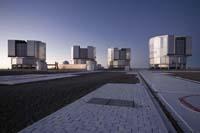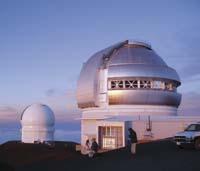2009/10/01
257. zenbakia

eu es fr en cat gl
Aparecerá un contenido traducido automáticamente. ¿Deseas continuar?
Un contenu traduit automatiquement apparaîtra. Voulez-vous continuer?
An automatically translated content item will be displayed. Do you want to continue?
Apareixerà un contingut traduït automàticament. Vols continuar?
Aparecerá un contido traducido automaticamente. ¿Desexas continuar?
Tliltepetl, the house of the millimetric eye
Text created by automatic translator Elia and has not been subsequently revised by translators.
Elia Elhuyar
Tliltepetl, the house of the millimetric eye
01/10/2009 | Roa Zubia, Guillermo | Elhuyar Zientzia Komunikazioa

(Photo: INAOE/www.lmtgtm.org)
Before building the telescope, the technicians worked hard to find the most appropriate place to build
It seems that the Great Millimeter Telescope looks to the Gulf of Mexico, at the edge of a large mountain in front of the Gulf. But the telescope has been built to focus on space, and the reason is that many millimeter waves of space reach that edge, at least compared to many other parts.
The top of the volcano Tliltepetl is very high, has an appropriate place for the installation of a giant telescope (even for the road to it) and, above all, has a very transparent sky for millimeter waves. Its superior atmosphere is very dry, with little humidity, which is essential for the observation of millimeter waves, which are absorbed by water vapor.
But, optionally, there were other similar suitable places to install the telescope. The Tliltepetl volcano was chosen for being the best, but after many tests. They studied more than ten mountains of more than three thousand meters, including the volcanoes Nevado de Toluca (Xinantecatl, 4.680 m), Cofre de Perote (Nauhcampatepetl, 4.300 m) and La Malinche (Matlalcueyetl, 4.420 m). Mexico's highest volcanoes exceed 5,000 meters (Citlatlaltepetl or Pico de Orizaba 5,610 m, Popocatepetl 5,500 m and Iztaccihuatl 5,220 m), but they were not orographically suitable and no quality tests of the millimeter sky were performed.
Looking for the clean sky
To perform the tests, they had to climb each mountain with tools to measure the transparency of the sky. "Transparency tests are done through a radio meter," explains Itziar Aretxaga. "The radiometer measures the millimeter emission of the atmosphere in a maximum celestial circle (from the zenith to the horizon to form the maximum circle with the earth area on the same plane). As the layers of the upper atmosphere are very cold, they become very powerful millimeter sources, a million times brighter than our distant millimeter galaxies."
Tests are performed in a maximum circle to measure the transparency of radiation from all angles. In fact, the millimeter waves of the stars seen near the horizon must pass through much of the atmosphere than those seen in the zenith.
In addition, they are permanent evidence, since transparency varies according to the time of year. As a result of the measurements, astronomers know that in the dry season (autumn, winter and spring) waves between 0.85 and 4 mm look better, while in the wet season (summer) the atmosphere is transparent for waves between three and four millimeters.
Above, telescopes
A ray of radiation reaching Earth from far space has remained on the road for years without any obstacles. It only needs a microsecond to travel the last 400 kilometers, but that is where most of the obstacles of the entire journey are found when crossing the Earth's atmosphere.

VLT telescope at Cerro Paranal in Chile.
(Photo: Recent searches Heyer/ESO)
First you will find a few molecules. They are very few and will probably not affect you. In the next 300 kilometers, little by little, they will increase, but the real obstacle will be in the last 50 kilometers. Throughout this time there are increasingly dense areas, arranged in layers at the beginning and in whirlpools. Lightning collides with these molecules and can occur from everything. A collision may send you back into space, perhaps not, but, almost certainly, collisions will make you change direction; you may lose energy in this process and change frequency. It may never reach the surface of the earth if a molecule absorbs it. But it may come. Astronomers are waiting with open eyes from giant telescopes.

(Photo: Guillermo Roa)
However, the land surface is very wide and telescopes capture a very small part. Most incoming rays will be lost. Astronomers should identify places where rays have fewer obstacles to reach the Earth's surface to install telescopes, i.e. the geographic points of the transparent atmosphere. And so, most of the large telescopes are on the earth's surface, but leaving as much of the atmosphere as possible below.

Gemini North Telescope at Mauna Kea Viewpoint in Hawaii.
(Photo: Steve Cadman)
The world's most outstanding observatories, infrared and millimetric, are built at high altitude. The Roque de los Muchachos Observatory, located on the Canary Island of La Palma, and the Campanas Observatory in Chile, in the Atacama Desert, exceed approximately 2,500 meters and, about 2,700 meters, are the observatories of the La Serena area, also in Chile. Far above them are the viewpoint of the Mauna Kea volcano in Hawaii, about 4,200 meters and the viewpoint of the Chajnantor plain of the Atacama Desert, 5,100 meters. Therefore, the Tliltepetl volcano, in which the Great Millimeter Telescope is located, can be considered as a high viewpoint, 4,600 meters high.
Roa Bridge, Guillermo
Services
257
2009
Services
020
Technology
Article
Other









